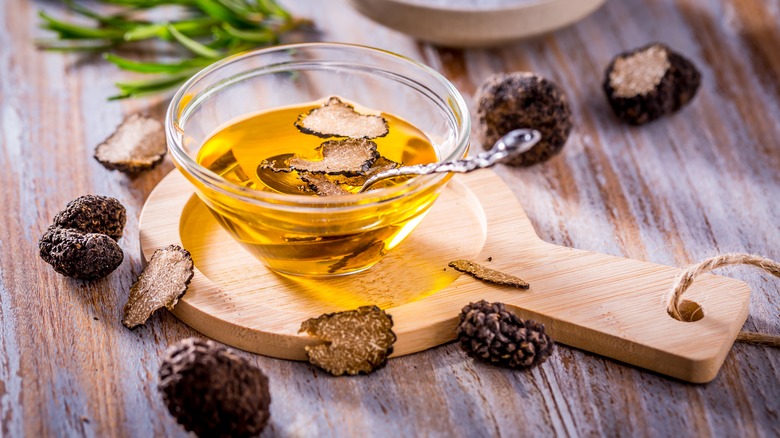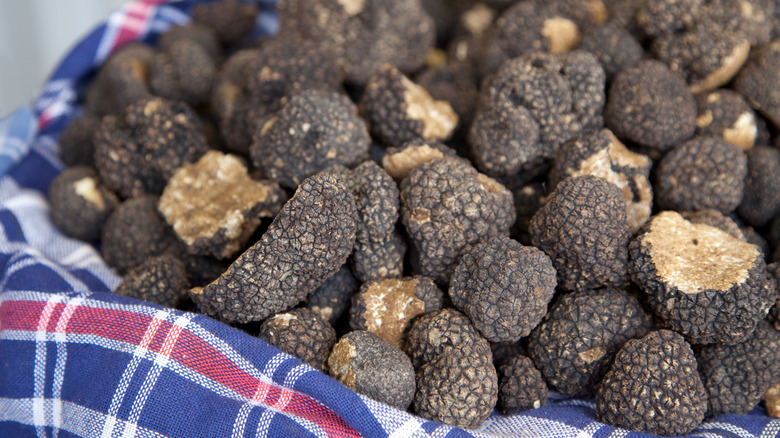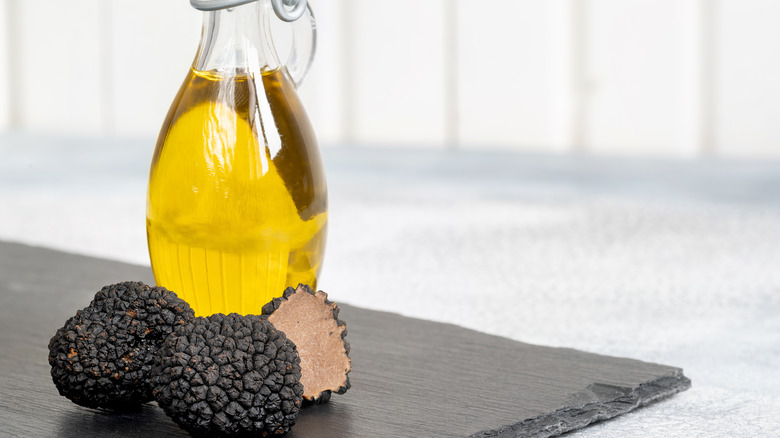The Label Clues That Can Tell You If Truffle Oil Is The Real Deal
Truffle oil is a controversial ingredient — while menus across the country over last decade have featured dishes like truffle fries doused in this fancy liquid, a lot of chefs don't like the stuff because it often contains no actual truffles. If you're determined to get your hands on some real, non-imitation truffle oil, there are a few things you can look out for, starting with the label.
You'll want to check the ingredient list on the back of the bottle for some indication of real truffles being used to produce the oil. If real truffles are used to produce it, you should find an ingredient along the lines of "natural truffle aroma." Be warned, though: The word "aroma" on its own isn't a guarantee of the real deal — one court case in America centered on an imitation truffle oil that listed olive oil and "aroma" as its ingredients. Lawyers argued that this was false advertising, but the fake oil producer ultimately won. So while artificial truffle oil might seem shady, it's completely legal, and it's up to buyers to check the label. Even the ingredient "truffle aroma" might be fake; you'll really want to look out for the phrasing "natural truffle aroma". And if there are various chemicals listed in the ingredients, that's a red flag — avoid that oil.
What else to look out for in your truffle oil
If you're unsure whether a truffle oil is real or fake and you can't figure it out based on the label, there are other clues you can use. These may require a refined sense of taste, and it could be a tricky process if you're unfamiliar with the flavor of truffles. You can try tasting the oil — it should be subtle and nuanced in its flavor profile. If the taste is rather one-dimensional and not layered, you may have the fake stuff. Synthetic truffle oil tends to be rather bold and even overpowering, so that's something to watch out for. Black truffles and white truffles are different; expect an earthy flavor from black truffle oil and a lighter, garlicky taste with the white variety. If you can see small pieces of truffle inside the bottle, that's also a good sign that it's real.
Of course, the catch here is that you'll have to smell or taste the oil, so unless your store has a sample bottle open, you'll probably need to buy before you try. But at least if it turns out to be fake, you'll know for the future (or you could try getting a refund).
Why fake truffle oil is everywhere
A key reason why there's so much fake truffle oil out there is money. Truffles are very expensive and tend to be highly sought-after. So, truffle oil is a clever workaround from an economic point of view. Even real truffle oil tends to be made with very, very small amounts of actual truffles. This allows manufacturers and restaurants to charge truffle-level prices for a product that contains very little of it.
For makers of synthetic (that is, fake) truffle oil, the advantages are even bigger: They're selling something that's seen as an expensive product, but without even having to invest in the luxury ingredient named on the label. Synthetic truffle oil leans heavily on a compound called 2,4-dithiapentane that's known to impart the scent of white truffles (although it's just one of many compounds found in real truffles) — it's usually mixed with olive oil and other flavoring molecules. And while synthetic truffle oil will often be sold for cheaper than the real deal, the companies making it can still sell it like a premium product and pocket the profits without ever spending a cent on expensive truffles. And of course, some chefs and home cooks jump at the chance to get access to such a premium product for a relatively affordable price — it's just too bad it's often not the real deal.


